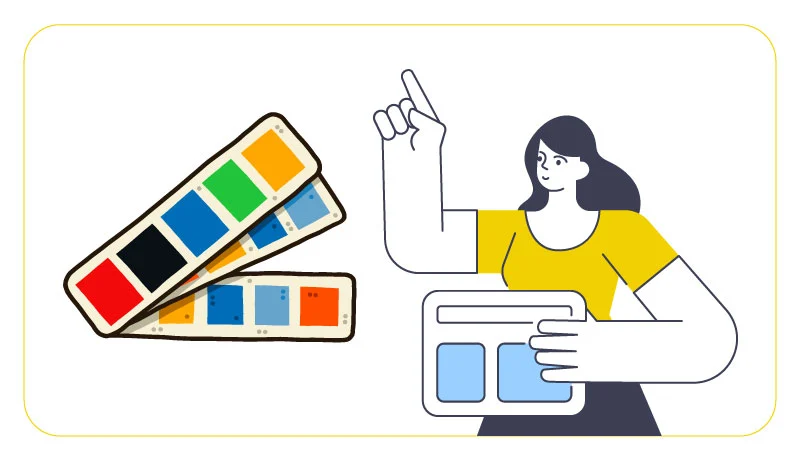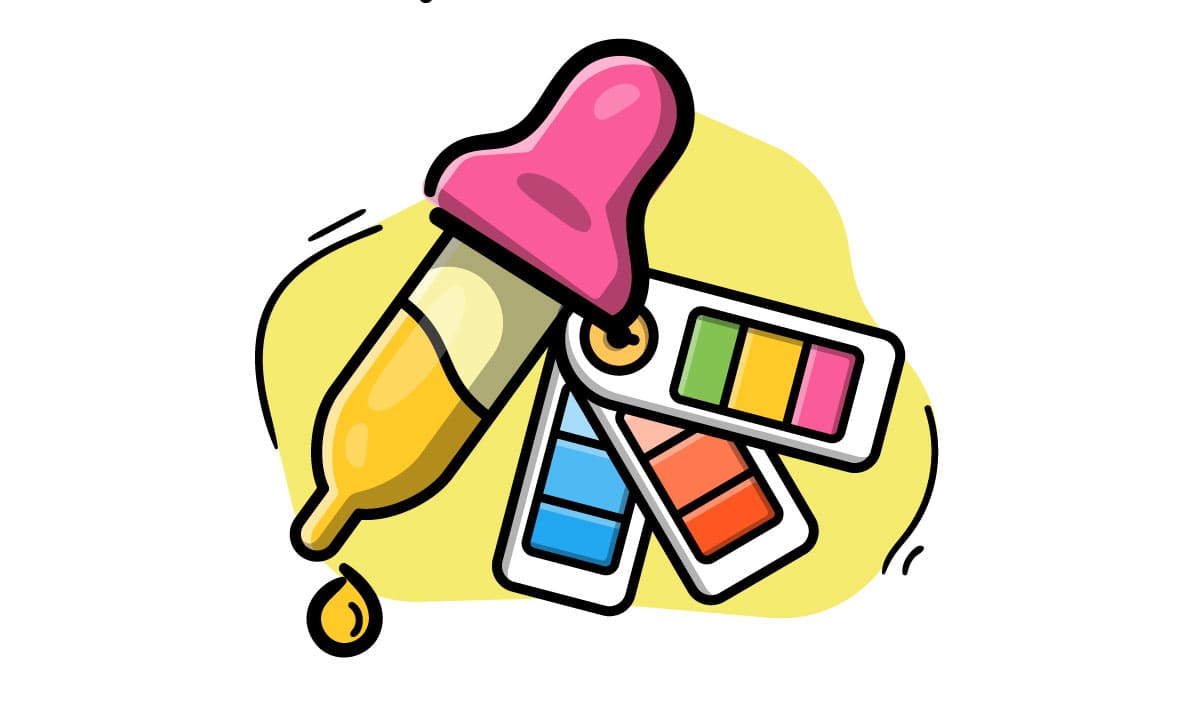In today’s digital era, businesses are always looking for innovative ways to stand out in the crowded online market. One of the most effective ways to make a lasting impression on potential customers is through the use of color. But with so many options available, it can be overwhelming to decide on the best colors for digital marketing.

In this article, we’ll explore the psychology of color, color schemes, and popular color choices to help you make informed decisions about the colors you use in your digital marketing campaigns. By the end of this article, you’ll have a better understanding of how color can impact your online presence and how to choose the best colors for your brand and audience. So, let’s dive into the world of color and discover the best colors for digital marketing!
The Psychology of Color in Digital Marketing
The psychology of color is a fascinating topic that has been studied extensively in the world of marketing. When it comes to digital marketing, understanding how color can impact emotions and behavior is crucial for creating effective campaigns. Different colors can evoke different emotions and associations in people, which can in turn influence their purchasing decisions.
So, what are the best colors for marketing? It really depends on the message you want to convey and the audience you’re targeting. For example, blue is often associated with trust and professionalism, making it a popular choice for finance and healthcare industries. Red, on the other hand, is associated with energy and excitement, making it a great choice for promoting sales and discounts.

But it’s important to note that there are no hard and fast rules when it comes to color in digital marketing. In fact, the most effective use of color often involves breaking the rules and creating something unique and attention-grabbing. For example, using a bold and unexpected color scheme can help a brand stand out and differentiate itself from competitors.
Ultimately, the best colors for marketing are the ones that resonate with your audience and effectively communicate your brand message. By understanding the psychology of color and its impact on emotions and behavior, you can make informed decisions about the colors you use in your digital marketing campaigns and create more engaging and effective content.
Color Schemes for Effective Digital Marketing
Color schemes are an important aspect of effective digital marketing. They can evoke emotions, create a cohesive brand identity, and influence consumer behavior. But with so many options available, it can be difficult to know where to start when selecting a color scheme for your digital marketing campaign.
When choosing a color scheme, it’s important to consider factors such as your brand values, target audience, and industry trends. For example, a brand that values innovation and creativity might choose a bold and vibrant color scheme, while a more traditional brand might opt for a more muted and classic color palette.
Another factor to consider is the impact of design trends and cultural shifts on color choices in digital marketing. For example, the rise of minimalism in design has led to a trend of using simple and monochromatic color schemes, while the increased focus on sustainability has led to a trend of using natural and earthy colors.
Once you have an understanding of your brand values, target audience, and design trends, you can start to explore different color schemes and combinations. Some popular color schemes for digital marketing include complementary colors, monochromatic colors, and analogous colors.
Complementary colors, which are opposite each other on the color wheel, can create a bold and eye-catching contrast. Monochromatic color schemes, which use different shades of the same color, can create a harmonious and sophisticated look. Analogous color schemes, which use colors that are next to each other on the color wheel, can create a cohesive and calming effect.
Ultimately, the best color scheme for your digital marketing campaign is one that effectively communicates your brand message, resonates with your target audience, and creates a cohesive and visually appealing experience. By understanding the factors that influence color choices and exploring different color schemes, you can create effective and engaging digital marketing content.
Top Color Choices for Digital Advertising
Color is a powerful tool in digital advertising. It can attract attention, evoke emotion, and influence consumer behavior. But which colors are the most effective for digital advertising campaigns?
One of the top color choices for digital advertising is red. This color is associated with energy, excitement, and urgency, making it a great choice for promoting sales and limited-time offers. Red can also increase heart rate and create a sense of urgency, which can help drive conversions.
Another effective color choice for digital advertising is blue. This color is often associated with trust, professionalism, and security, making it a popular choice for finance, healthcare, and technology industries. Blue can create a sense of calm and reliability, which can help establish trust with potential customers.

Green is another popular color for digital advertising, particularly in the context of eco-friendly or sustainable products. This color is associated with nature, growth, and health, making it a great choice for brands that promote sustainability and environmental responsibility.
Yellow is a high-visibility color that can grab attention and create a sense of excitement. It is often used in digital advertising to highlight important information or to create a sense of playfulness and fun.
But it’s important to remember that the most effective color choices for digital advertising depend on your brand message, target audience, and campaign goals. By understanding the psychology of color and its impact on consumer behavior, you can make informed decisions about the colors you use in your digital advertising campaigns and create more effective and engaging content.
Examples of successful digital advertising campaigns that use these colors include McDonald’s use of red and yellow in their branding, which creates a sense of urgency and playfulness, and IBM‘s use of blue, which creates a sense of professionalism and trust. Ultimately, the best color choices for digital advertising are the ones that effectively communicate your brand message, resonate with your target audience, and drive conversions.
How to Choose Colors for Digital Marketing Campaigns
Choosing the best colors for branding in digital marketing can be a challenging task, but it is essential to establish a strong visual identity and connect with your target audience. Here are some tips to help you choose the right colors for your digital marketing campaigns:
- Consider your brand personality: Your brand personality plays a vital role in choosing the right colors. For example, if your brand is playful and fun, you might consider using bright and bold colors like red, orange, or yellow. If your brand is more serious or professional, you might opt for muted and subdued colors like blue or gray.
- Understand color psychology: The psychology of color can help you choose the right colors that resonate with your audience. For example, blue is associated with trust and reliability, while green is associated with nature and health. Understanding the emotions and behaviors that different colors evoke can help you choose colors that align with your brand message and connect with your target audience.
- Consider color trends and cultural influences: Color trends and cultural influences can also impact your color choices. For example, if you are targeting a younger audience, you might consider using bright and bold colors that are popular with that demographic. Alternatively, if you are targeting an international audience, you might need to consider the cultural significance of different colors in different regions.
- Test and optimize your color choices: Once you have selected your colors, it is essential to test and optimize your color choices to ensure that they are effective. A/B testing can help you determine which colors are most effective in driving engagement and conversions, and ongoing optimization can help you refine your color choices over time.

Ultimately, the best colors for branding in digital marketing are the ones that effectively communicate your brand message, resonate with your target audience, and establish a strong visual identity for your brand. By considering your brand personality, understanding color psychology, considering color trends and cultural influences, and testing and optimizing your color choices, you can choose the right colors for your digital marketing campaigns and establish a strong and effective brand identity.
Popular Colors for Digital Marketing Campaigns
As with any design trend, popular colors for digital marketing campaigns can change rapidly. However, certain colors have remained popular and effective over the years. Here are some of the most popular colors for digital marketing campaigns and why they work so well:
- Blue: Blue is a highly versatile color that is often associated with trust, reliability, and professionalism. It is a popular choice for tech companies, financial institutions, and healthcare providers. Additionally, shades of blue like turquoise and teal can evoke a sense of calmness and serenity, making them popular choices for wellness and beauty brands.
- Green: Green is associated with growth, health, and nature. It is a popular choice for organic food brands, environmental organizations, and health and wellness companies. Additionally, darker shades of green like forest green can be used to convey a sense of luxury and sophistication.
- Red: Red is a highly energetic color that is often associated with passion, excitement, and urgency. It is a popular choice for e-commerce brands, as it can be used to create a sense of urgency and encourage impulse purchases. Additionally, red can also be used to convey a sense of love and romance, making it a popular choice for dating apps and websites.
- Yellow: Yellow is a bright and sunny color that is often associated with happiness, optimism, and energy. It is a popular choice for food and beverage brands, as it can stimulate the appetite and evoke a sense of freshness. Additionally, shades of yellow like gold and mustard can be used to convey a sense of luxury and sophistication.
- Black: While not a traditional “color,” black is a popular choice for digital marketing campaigns due to its versatility and sophistication. It is often used to convey a sense of elegance and luxury and is a popular choice for fashion and beauty brands. Additionally, black can be used to create high-contrast designs that stand out in a crowded digital landscape.

The most popular colors for digital marketing campaigns are those that effectively communicate a brand’s message, resonate with its target audience, and create a strong visual identity. By staying attuned to current color trends and understanding the emotions and behaviors that different colors evoke, digital marketers can choose colors that effectively drive engagement and conversions for their brands.
How Color Impacts Digital Marketing Metrics
Color can have a significant impact on digital marketing metrics, including click-through rates, conversion rates, and even overall brand perception. Here are some key ways that color can impact digital marketing metrics:
- Brand recognition: Color is one of the most important factors in creating a strong brand identity. When a brand consistently uses the same colors across all of its marketing channels, it can help to create a sense of recognition and familiarity among consumers. This can lead to increased trust and loyalty, which can ultimately drive higher conversion rates and revenue.
- Emotional response: Different colors can evoke different emotional responses in consumers. For example, warm colors like red and orange can create a sense of urgency or excitement, while cool colors like blue and green can evoke feelings of calmness and relaxation. By understanding the emotional response that different colors evoke, digital marketers can strategically choose colors that align with their brand message and target audience.
- Visual appeal: In a crowded digital landscape, it’s important for marketing materials to stand out visually. Bright, bold colors can grab attention and encourage engagement, while muted or neutral colors can create a sense of sophistication and elegance. By choosing colors that align with their brand message and target audience, digital marketers can create visually appealing marketing materials that drive clicks and conversions.
- Cultural relevance: Color trends can vary across different cultures and regions. For example, in Western cultures, red is often associated with passion and excitement, while in many Asian cultures, it is associated with luck and prosperity. By understanding the cultural relevance of different colors, digital marketers can choose colors that resonate with their target audience and drive engagement.
- Accessibility: Finally, it’s important to consider the accessibility implications of color in digital marketing. For example, individuals with color vision deficiencies may have difficulty distinguishing between certain colors. By choosing high-contrast color schemes and providing alternative text or design elements, digital marketers can ensure that their marketing materials are accessible to all users.

Ultimately, the impact of color on digital marketing metrics is complex and multifaceted. By understanding the emotional and behavioral responses that different colors evoke, digital marketers can strategically choose colors that drive engagement, conversions, and overall brand success.
Conclusion
Choosing the best colors for digital marketing is a critical component of creating a successful marketing strategy. By understanding the psychological impact of color, considering factors like brand identity and target audience, and monitoring the impact of color on metrics like click-through rates and conversion rates, digital marketers can create visually appealing, emotionally resonant marketing materials that drive engagement and revenue. Whether you’re selecting color schemes for a website, creating digital advertising campaigns, or designing social media graphics, choosing the right colors can make all the difference in the success of your digital marketing efforts.
FAQs
How do colors affect digital marketing performance?
Colors can affect digital marketing performance by impacting emotions and behavior, influencing brand perception, and increasing brand recognition and recall.
What are the best color combinations for digital marketing?
The best color combinations for digital marketing depend on factors like brand identity, target audience, and design trends, but popular combinations include complementary colors and monochromatic schemes.
How can I use color to improve my digital marketing campaigns?
To use color to improve your digital marketing campaigns, consider the psychological impact of color, match colors with your brand identity and target audience, and track the impact of color on metrics like click-through rates and conversion rates.
Which colors are most effective for digital advertising?
The most effective colors for digital advertising depend on the goals of your campaign, but colors like blue, green, and red are often used because of their association with trust, growth, and urgency, respectively.
What is the meaning behind different colors in digital marketing?
Different colors in digital marketing have different meanings and associations, such as blue representing trust and security, green representing growth and nature, and red representing urgency and excitement.







 Facebook Ads Spy Tool
Facebook Ads Spy Tool TikTok Ads Spy Tool
TikTok Ads Spy Tool